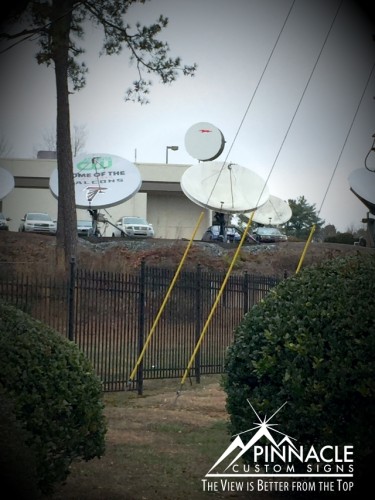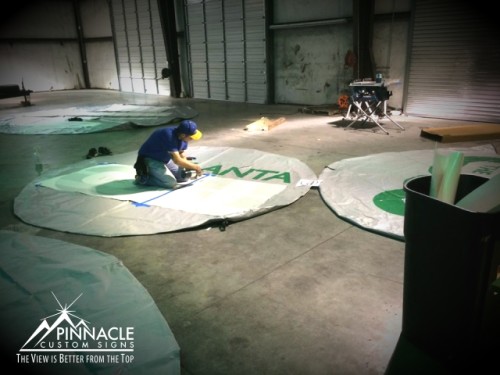Satellite Dish Covers Draw Attention to a Local TV Station
Laura Hale, Creative Services Director from the CW69 network in Atlanta Georgia came to us with a unique idea. They have several large satellite dishes used for their programing that are located just off one of the major interstates in Atlanta. They were in the process of getting covers for all of their satellite dishes and called to see if it was possible to put their logos on these dish covers using vinyl graphics.

Although we have applied vinyl to many different surfaces in the past, we have never done so on this type of material before. Therefore, we thought it would be best to do a test using a smaller sample cover in order to determine the right material to use. Most of the surfaces we apply vinyl to are rigid. Because these were highly flexible, we wanted to be sure we determined the right solution for the project.
After several tries we decided to use a cast vinyl, Avery MPI 1005, with a cast laminate – the same material we use on vehicle wraps. Cast vinyl is considered a specialty vinyl which, due to the manufacturing process, is able to stretch and cover more curved structures.
The station decided to focus their advertising on three of their key shows: Family Feud, Flash, and the Atlanta Falcons. Once the graphics and the materials were decided,we got to work on the project.
As the unique project progressed, we found some challenges that needed to be taken into consideration:
- Since the dish covers were round and are pointed in different directions it was key for us to know the center line in order to have the logos on the dish straight. The design for each of the covers had to also work around the zippers where the probe went through them.
- Some of the larger dish covers needed the graphics to be paneled (which is a fancy way of saying that they needed to be printed in sections due to the maximum width that can be printed on our printer) and how to best accomplish that with the way the covers are manufactured.
- The dish covers were stiff and wrinkly which made a challenge of getting the graphics to lay flat for installation.
- There was some sort of waterproof treatment that would prevent the adhesive on the graphics from sticking to the surface which had to be removed before we began laying the graphics on them.

It took some practice to determine the best installation method to use for the application. This included using the squeegee to try to smooth out the dish cover, placing the graphic on the cover, applying heat and then using a foam roller to press it onto the surface.
The first one took more than one whole day to complete. But, once we figured out the best methodology, subsequent covers were completed in less time. It then took two days to complete the remaining four.
Due to the large size of the dish covers, we had to do this job on the floor, as they would not fit on our work tables. On the plus side, we had the space available in our new facility; however, the floor was pretty cold, which didn’t help the adhesive on the graphics to stick, not to mention the fact that working on the ground for three days takes some wear on the knees.
We delivered them to the station and now they are in the process of scheduling the cover installs and are expected be up by the end of January.






